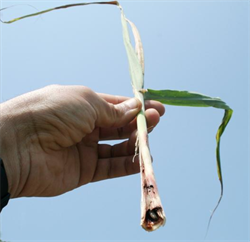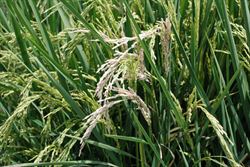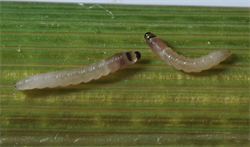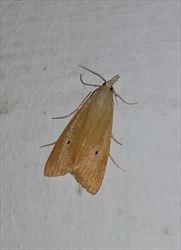- Moderately widespread – not in Americas or Caribbean. In Australia, PNG.
- Rice, cultivated and wild. Major pest of lowland and deep-water rice.
- Eggs (groups of 80) on upper half of seedling leaves, covered in scales; larvae white at first, bore into stems causing deadhearts (vegetative stage) or whiteheads (panicle stage), pale yellow to yellowish-green, brownish head; up to 20mm. Pupate in silken cocoons in base of stems or below ground in stubble, remaining dormant during adverse conditions (e.g., droughts). Female pale-yellow or light-brown forewings with single black spot; wingspan 32mm. Males, two rows of spots at tips of forewings.
- Spread: eggs on seedling; larvae blown in the wind on silken threads; as pupae in harvested stems, and on machinery; as adults on the wing.
- Biosecurity: risks associated with produce contaminated with rice stems (straw) containing larvae and/or pupae.
- Biocontrol: parasitoids – Telenomus, Tetrastichus, Trichogramma species; predators – long-horned grasshoppers, spiders.
- Cultural control: prepare land well (destroy pupae from previous crop); use short, early-maturing varieties; before transplanting, hand-pick eggs, or cut upper parts of leaves; avoid over-lapping crops; raise irrigation level periodically; weed; remove deadhearts and kill larvae; apply split N applications; harvest at ground-level; plough in stubble; if possible, irrigate field.
- Chemical control: economic threshold: i) count egg masses on 20 hills diagonally across field; ii) collect eggs iii) incubate; v) spray, if more parasitoids emerge than larvae. Avoid broad-spectrum insecticides; use bt; abamectin, or spinosad.









